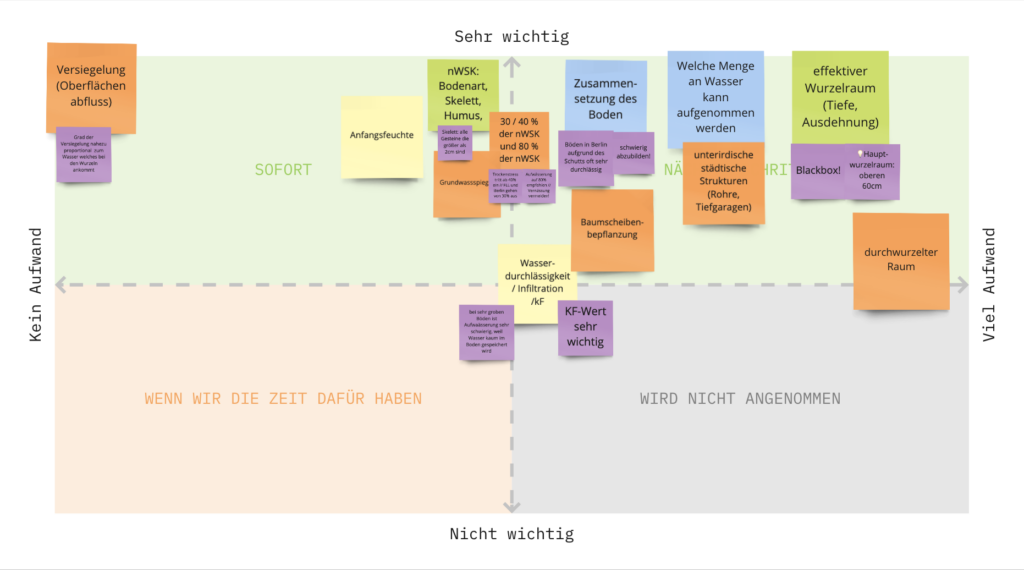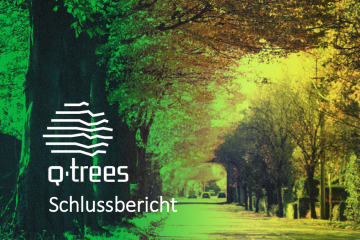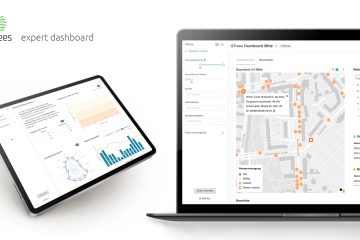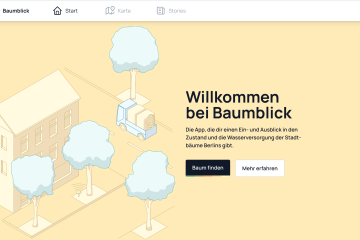Nach knapp zweimonatiger Projektlaufzeit haben wir uns am 25. Januar 2022 einen ersten Workshop mit Projektpartnern und weiteren Akteuren der Berliner Baumlandschaft durchgeführt. Ziel des Workshops war es in die Thematik "Bewässerung von Stadtbäumen" einzutauchen und zu verstehen anhand welcher Parameter der Bewässerungsbedarf von Bäumen berechnet werden kann.
Our experts Wolfgang Leder - Head of the Roads and Green Spaces Office (short: SGA) Berlin Mitte -, Dr. Katharina Weltecke - expert for soil science and tree locations - and Christian Hönig - tree protection officer at BUND Berlin - discussed current challenges and methods for watering trees with us in the expert workshop. Through the workshop we were able to learn about the following following topics :
- Current needs and objectives for the irrigation of street and plant trees in Berlin,
- Data and parameters relevant for the assessment of the state of the trees and therefore for the planned development of an intelligent predictive model for the irrigation of urban trees,
- Methods and calculation models that are already used for watering urban trees - from simple rules of thumb to complex formulas.
Regarding the needs of trees, some challenges and possible solutions have been suggested. All experts agree that more space for the trees and their root systems would clearly improve their situation, as this would increases the absorption capacity and the infiltration capacity of the soil substrate. Here, for example, the unsealing of tree grates, i.e. opening and enlarging the area under the tree, would be a concrete measure that can be taken. This can be taken into account when planning public spaces, e.g. by designing tree lanes that are free of cables and allow plenty of room for the tree roots. This would also make trees more resilient to strong storms.
Our experts also discussed measures that are currently being used to irrigate street trees and identified potential for optimization. A specific measure is the installation of watering sacks for young and old trees, since such sacks make the water available over a longer period of time. Another measure is the covering of tree grates with grit stones. Grit prevents compaction of the soil and thus enables large amounts of water to be absorbed.
Some of the methods can actually be described by mathematics and optimized by calculation models, which is why the second part of the workshop dealt with current prediction and calculation models. Some mathematical models are already used to calculate irrigation needs. Evatranspiration, i.e. the calculation of evaporation of water close to the ground, as well as transpiration (i.e. the release of water vapor through the stomata of the leaves), is a frequently used model for determining irrigation recommendations. The model for evatranspiration is based on the Penman-Monteith equation and is used worldwide. Other models, such as that of Prof. Roth-Kleyer, take into account other parameters, such as soil type or tree species, to determine irrigation needs. The aim of the QTrees funding project is, among other things, to compare and analyze these calculation models and ultimately to define an optimal approach for our own model.
We also found out which data and parameters are relevant for irrigation: weather data such as precipitation and temperature are of central importance when calculating water requirements. The amounts of precipitation and other weather data for the last few days and weeks can be easily accessed via the portals of the German Weather Service.

Other data such as soil type, while important, are a bit more difficult to obtain. Especially in large cities like Berlin, there are many different soil substrates, from sand to clay, and many soil structures are influenced by rubble or construction waste. Therefore, it is difficult to calculate how much root space, oxygen and water is effectively available to each tree. Tree physiological parameters also play a role. Some tree species, age and height influence the water requirements of individual trees. Some of this data is available in the City of Berlin's green areas information system (GRIS) and can be downloaded via the FIS-Broker portal.
The workshop has given us a deeper understanding of the challenges, data, methods and models that come into play for an intelligent irrigation recommendation. The results of the workshop will be used as the basis for an extensive requirements analysis. In the coming weeks, the QTrees consortium will conduct expert interviews in order to understand the needs of administrative staff and to be able to incorporate them into the development of the prediction model and an end-user application.
We would like to thank our experts for their active participation!


